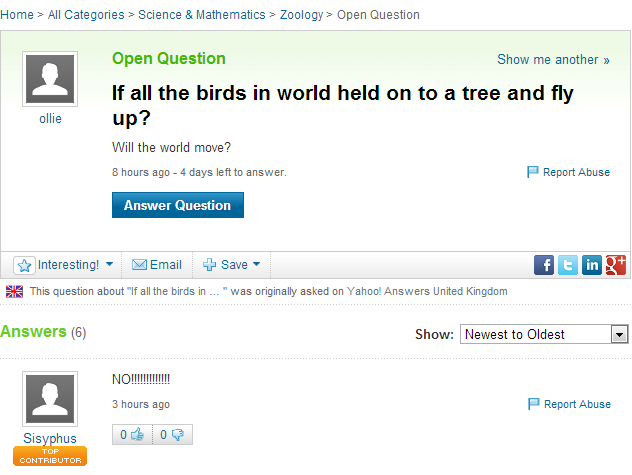originally posted at https://canmom.tumblr.com/post/871486...

This is an important question and deserves thorough consideration! People are far too quick to dismiss it in terms of such minor technicalities as “the tree isn’t strong enough”.
Suppose we have an indestructible ‘tree’ of sufficient size to house all the 200-400 billion birds in the world. Is there any way these birds can cause a noticeable acceleration of the world? (Short answer: no.)

The Earth’s atmosphere masses, in total, about 5×1018kg. This is about 1/1,200,000 of the mass of the whole Earth, so if the bird gang could launch our entire atmosphere away at once, the Earth would initially move in the opposite direction at 1/1,200,000 of the speed. It would slow down gradually after that, due to gravity. If the atmosphere was sent away with less than Earth’s escape velocity, it will eventually fall back down. (The surviving people of Earth, barely rebuilding their sheltered space-habitats in the remnants of civilisation in the first mega-storm when the atmosphere left, are flattened once again.)
Now, the bird-powered atmosphere-as-reaction-mass rocket engine faces a problem. (Possibly, multiple problems.) While hundreds of billions of birds could deliver enough energy to lift some of the atmosphere into space, they have a great difficulty concentrating all that energy into one flow that’s fast-enough moving to leave Earth. We’d to have to somehow arrange the flow to concentrate that energy and momentum into one small flow of air… but I fear birds can’t reach the pressures necessary to push it through, say, a de Laval nozzle.
Imagining we solve that problem, how much momentum can we hope to extract from 300 gigabirds?
A bird that can fly must be able to, at least for a while, displace as much momentum of air downwards per unit time as its own weight. It can save energy by using the same tricks that gliders use - flying in rising air such as thermals and ridge lift - but if there’s no rising air about, it needs to be providing the energy itself. So we can get a lower bound if we have the average mass of a bird.
Sadly, scientists have not spent time working out the average mass of a bird across all bird species. It’s almost as if that information is completely useless! [I did find a rather dubiously-sourced list of the masses of various parrots (typically hundreds of grams), and a paper from 1938 on the ways the mass of birds might vary (typically tens of grams for the species in the paper).]
Then again, we have so much variation in the estimate of the total number of birds, there’s nothing really to gain from a precise estimate of bird mass. Let’s guess a bird weighs \(100\unit{g}\). To stay aloft all at once, the birds must apply a combined force of \(30\unit{GN}\) (giganewtons).
Imagine they could apply that force directly to moving the Earth, ignoring the complications of having to lift the atmosphere off of the Earth. The Earth will accelerate at \(5\times10^{-15}\unit{ms^{-2}}\). By comparison, to keep the Earth in orbit, the sun must accelerate the Earth by \(r\omega^2=0.006\unit{m\,s^{-2}}\), which is about a thousand billion times more. So even neglecting gravity and the Earth being in the way of all the air, the birds are going to have difficulties.

Well then, let’s imagine we replace the natural birds of Earth with cyborg super-birds, each of which has the jet engine from an Airbus A380. (image sources: bird, jet)
Let’s first imagine they can apply their thrust directly to the Earth. The engines each have a max thrust of about \(360\unit{kN}\). The total max thrust of the bird engines together is about \(10^{17}\unit{N}\), bringing us up to about \(2\times 10^{-8} \unit{m\,s^{-2}}\). Still negligible compared to the sun. We’re not doing well here!
Alright, fine. Let’s say they hurl away the entire atmosphere all at once, at the escape velocity of the Earth (that is, just fast enough that it won’t ever come back). Initially, the Earth moves in the opposite direction at about \(10\unit{mm\,s^{-1}}\). This may be compared to the Earth’s orbital speed (relative to the sun) of \(\about30\unit{km\,s^{-1}}\), about three million times faster. After two seconds, the sun’s gravity has already produced an equivalent acceleration to our shedding of the entire atmosphere.
So a final question: how fast would the bird gang have to launch the atmosphere to de-orbit the Earth entirely, so that it never comes back to the sun?
The sun’s escape velocity at the Earth’s orbit is about \(42\unit{km\,s^{-1}}\), so we need to increase the Earth’s speed by about \(12\unit{km\,s^{-1}}\), meaning we need to add about \(7.4\times10^{28}\unit{kg\,m\,s^{-1}}\). For something as light as the atmosphere, we need to accelerate it to relativistic speeds. Using the formula for relativistic momentum, we need to launch the atmosphere away at 99.98% of the speed of light.
I think we might need a few more birds to pull that one off.
Comments